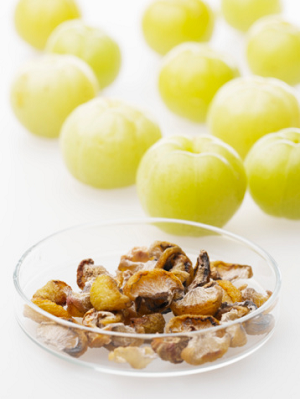Nov 14, 2025
Nov 14, 2025
Historical Description:
 Amla is worshipped as an auspicious fruit from the ancient time and respected as a symbol of good health. The festival Amala Navami is celebrated at the begining of winter season of Hindu calender, where Amla tree are socially and religiously propagated among people and cultivated for promotion of good health. In Hinduism, amla is regarded as a sacred tree worshipped as Mother Earth. Amla is one of the most often used herb in Indian Ayurveda. Chyavan rushi an ancient seer-was rejuvenated by Aswini-kumars by a preparation, chiefly containing fruits of Amla. Amla is a household medicinal plant in India. It has a reputation as a powerful rejuvenating herb. Indian Research shows that 8.75 mg of natural vitamin C from Amla is equivalent to 100mg of the most commonly used synthetic vitamin C. Amla prossesses the highest level of heat and storage stable vitamin C known to man.
Amla is worshipped as an auspicious fruit from the ancient time and respected as a symbol of good health. The festival Amala Navami is celebrated at the begining of winter season of Hindu calender, where Amla tree are socially and religiously propagated among people and cultivated for promotion of good health. In Hinduism, amla is regarded as a sacred tree worshipped as Mother Earth. Amla is one of the most often used herb in Indian Ayurveda. Chyavan rushi an ancient seer-was rejuvenated by Aswini-kumars by a preparation, chiefly containing fruits of Amla. Amla is a household medicinal plant in India. It has a reputation as a powerful rejuvenating herb. Indian Research shows that 8.75 mg of natural vitamin C from Amla is equivalent to 100mg of the most commonly used synthetic vitamin C. Amla prossesses the highest level of heat and storage stable vitamin C known to man.
Sanskrit: Amalaki, Hindi: Amala, English-Emblic Myrobalan, Marathi:Awala.
Main Synonyms: Amruta, Shiva, Shrifala, Dhatri, Panchrasa, Bahufala, Kayastha.
Latin name: Phyllanthus emblica
Family: Euphorbiaceae
Gana: Vayasthapana,Virechanopaga – (Charak); Triphala, Parushakadi – (Sushruta)
Botanical Description: The tree is a deciduous, small or middle-sized, with a crooked trunk, and spreading branches, leaves, subsessile 10-13 by 2.5-8 mm closely set along the branchlets, distichous, light green, glabrous, narrowly linear obtuse, imbricate when young. Flowers greenish yellow in axillary, fascicles on the leaf-bearing branchlets often on the naked portion below the leaves. Fruit 1.3-1.6 cm, fleshy, glabrous and pale yellow of three 2 seeded crustaceous cocci1.
Parts Used: Dried fruit, the nut or seed, leaves, bark and flowers, ripe fruits.
Habitat: The plant grows throughout India upto 4,500 ft.
Phytochemistry: The fruit is a rich source of ascorbic acid-Vitamin C. Ten gms of fresh fruits contain 600-900 mg of Vitamin C. The small fruit variant contains more Vitamin C then the large variant. According to recent work fruits lose Vitamin C more when dried in the sun than in the shade. Ellagic acid is present in bark.
Ayurvedic Properties:
Guna: Laghu, Ruksha, Rasa: All rasas present except Lavana.
Veerya: Sheeta.
Vipaka: Madhura.
Dosha: Tridoshahara.
Karma: Rasayana, Pramehaghna, Shukrala, Deepana, Keshya, Medhya, Chakshushya, Anulomana.
Pharmacology:
Alcoholic extract of the plant (1 gm/kg) has shown an increase in the cardiac glycogen and a decrease in serum GOT, GPT and LDH in isoprotenol pretreated rats, suggesting a cardio-protective action. It showed a reduction in serum cholesterol levels and a significant antiatherogenic effect. This study suggests that Vitamin C content alone may not be responsible for the antiatherogenic effect of the plant in animals.
Benefits of Amla:
Medical Research:
Ayurvedic Properties:
Pittahara: due to sweet taste and cooling energy.
Vatashamak: due to sour taste,
Kaphashamak: due to its astringent taste and drying action.
Rasayana: rejuvenative; Enhance digestion (dipanapachana), Treat constipation (anuloma), Reduce fever (jvaraghna), Purify the blood (raktaprasadana), Reduce cough (kasahara), Alleviate asthma (svasahara), Strengthen the heart (hrdaya), Benefit the eyes (chakshushya), Stimulate hair growth (romasanjana), Enliven the body (jivaniya), and enhance intellect (medhya).
Medicinal uses:The roots, leaves, seeds and chiefly fruit are used for mediicinal purpose.
External uses:
Internal uses:
Safety: The drug is not reported to have any side effects even after prolonged use.
Formulations and Dosage:
Chayavanaprash : 6-12 gms b.i.d.
Bramhyarasayan : 6-12 gms b.i.d.
Amalaki Rasayan : 6-12 gms b.i.d.
Triphala Churna : 2 gm b.i.d.
Rasayan Churna : 1-2 gms b.i.d.
Kalpa from literature: Sudarsanchurna, Agnikumarras, Jwarbhairavras, Vadvanalras, Sarvang sundarras, Jwarkesariras Shaubhagyavati, Sannipatbhairavras, Vidyadharras Lohasav, Takrarista, Chandraprabhavati, Agnitundivati, Lavangadivati Chyavanprash, Chandramrutras, Laxmivilasras, Nityodayaras, Mahakalyanvati, Yogeshwarras, Kamdhenuras, Somnathras
Image (c) Gettyimages.com
16-Aug-2013
More by : Dr. Sarika Rathod

|
i want to know about SHIVA RASAYANA,and its ingredients.thanks |

|
is ladies can use rasayan churna ? |